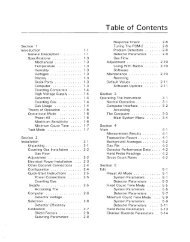Rad Data Handbook 20.. - Voss Associates
Rad Data Handbook 20.. - Voss Associates
Rad Data Handbook 20.. - Voss Associates
You also want an ePaper? Increase the reach of your titles
YUMPU automatically turns print PDFs into web optimized ePapers that Google loves.
SHIELDING MATERIALS<br />
α<br />
a single sheet of paper<br />
β -<br />
low Z, such as plastic or aluminum<br />
γ<br />
high Z, such as tungsten<br />
mixed β - /γ low Z, then high Z<br />
neutron hydrogenous material to thermalize (such as<br />
polyethylene) then neutron absorber (such as Cd, B, Li, Hf),<br />
then high Z to absorb "capture gammas"<br />
Photon Half-Value Layers in CM<br />
100 KeV 600 KeV 1 MeV 2 MeV<br />
U 0.005 0.25 0.48 0.78<br />
W 0.008 0.35 0.58 0.82<br />
Pb 0.012 0.52 0.90 1.35<br />
Sn 0.06 1.20 1.38 1.80<br />
Cu 0.18 1.01 1.70 1.65<br />
Fe 0.25 1.15 1.32 1.55<br />
Al 1.12 3.30 4.45 5.90<br />
Concrete 1.8 3.8 4.6 6.2<br />
Water 4.2 7.8 9.6 14.2<br />
This table applies to a thin shield and no provision is made for<br />
buildup factor. Always perform a radiation measurement to<br />
confirm adequacy of shield.<br />
Tenth-Value Thickness<br />
Simply multiply the half-value thickness by the square root of<br />
10 (3.162) to get the tenth-value thickness.<br />
Example: A half-value thickness of concrete for Cs-137<br />
gamma radiation is 3.8 cm.<br />
The tenth-value thickness is 3.8 cm x 3.162 = 12 cm.<br />
53<br />
SHIELDING MATERIALS<br />
α<br />
a single sheet of paper<br />
β -<br />
low Z, such as plastic or aluminum<br />
γ<br />
high Z, such as tungsten<br />
mixed β - /γ low Z, then high Z<br />
neutron hydrogenous material to thermalize (such as<br />
polyethylene) then neutron absorber (such as Cd, B, Li, Hf),<br />
then high Z to absorb "capture gammas"<br />
Photon Half-Value Layers in CM<br />
100 KeV 600 KeV 1 MeV 2 MeV<br />
U 0.005 0.25 0.48 0.78<br />
W 0.008 0.35 0.58 0.82<br />
Pb 0.012 0.52 0.90 1.35<br />
Sn 0.06 1.20 1.38 1.80<br />
Cu 0.18 1.01 1.70 1.65<br />
Fe 0.25 1.15 1.32 1.55<br />
Al 1.12 3.30 4.45 5.90<br />
Concrete 1.8 3.8 4.6 6.2<br />
Water 4.2 7.8 9.6 14.2<br />
This table applies to a thin shield and no provision is made for<br />
buildup factor. Always perform a radiation measurement to<br />
confirm adequacy of shield.<br />
Tenth-Value Thickness<br />
Simply multiply the half-value thickness by the square root of<br />
10 (3.162) to get the tenth-value thickness.<br />
Example: A half-value thickness of concrete for Cs-137<br />
gamma radiation is 3.8 cm.<br />
The tenth-value thickness is 3.8 cm x 3.162 = 12 cm.<br />
53<br />
SHIELDING MATERIALS<br />
α<br />
a single sheet of paper<br />
β -<br />
low Z, such as plastic or aluminum<br />
γ<br />
high Z, such as tungsten<br />
mixed β - /γ low Z, then high Z<br />
neutron hydrogenous material to thermalize (such as<br />
polyethylene) then neutron absorber (such as Cd, B, Li, Hf),<br />
then high Z to absorb "capture gammas"<br />
Photon Half-Value Layers in CM<br />
100 KeV 600 KeV 1 MeV 2 MeV<br />
U 0.005 0.25 0.48 0.78<br />
W 0.008 0.35 0.58 0.82<br />
Pb 0.012 0.52 0.90 1.35<br />
Sn 0.06 1.20 1.38 1.80<br />
Cu 0.18 1.01 1.70 1.65<br />
Fe 0.25 1.15 1.32 1.55<br />
Al 1.12 3.30 4.45 5.90<br />
Concrete 1.8 3.8 4.6 6.2<br />
Water 4.2 7.8 9.6 14.2<br />
This table applies to a thin shield and no provision is made for<br />
buildup factor. Always perform a radiation measurement to<br />
confirm adequacy of shield.<br />
Tenth-Value Thickness<br />
Simply multiply the half-value thickness by the square root of<br />
10 (3.162) to get the tenth-value thickness.<br />
Example: A half-value thickness of concrete for Cs-137<br />
gamma radiation is 3.8 cm.<br />
The tenth-value thickness is 3.8 cm x 3.162 = 12 cm.<br />
53<br />
SHIELDING MATERIALS<br />
α<br />
a single sheet of paper<br />
β -<br />
low Z, such as plastic or aluminum<br />
γ<br />
high Z, such as tungsten<br />
mixed β - /γ low Z, then high Z<br />
neutron hydrogenous material to thermalize (such as<br />
polyethylene) then neutron absorber (such as Cd, B, Li, Hf),<br />
then high Z to absorb "capture gammas"<br />
Photon Half-Value Layers in CM<br />
100 KeV 600 KeV 1 MeV 2 MeV<br />
U 0.005 0.25 0.48 0.78<br />
W 0.008 0.35 0.58 0.82<br />
Pb 0.012 0.52 0.90 1.35<br />
Sn 0.06 1.20 1.38 1.80<br />
Cu 0.18 1.01 1.70 1.65<br />
Fe 0.25 1.15 1.32 1.55<br />
Al 1.12 3.30 4.45 5.90<br />
Concrete 1.8 3.8 4.6 6.2<br />
Water 4.2 7.8 9.6 14.2<br />
This table applies to a thin shield and no provision is made for<br />
buildup factor. Always perform a radiation measurement to<br />
confirm adequacy of shield.<br />
Tenth-Value Thickness<br />
Simply multiply the half-value thickness by the square root of<br />
10 (3.162) to get the tenth-value thickness.<br />
Example: A half-value thickness of concrete for Cs-137<br />
gamma radiation is 3.8 cm.<br />
The tenth-value thickness is 3.8 cm x 3.162 = 12 cm.<br />
53













